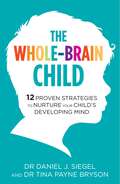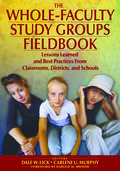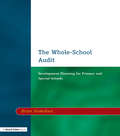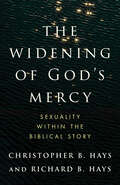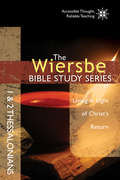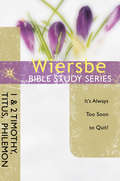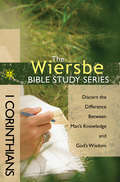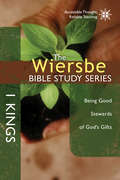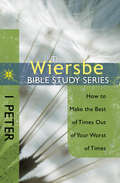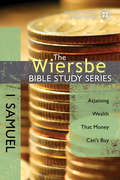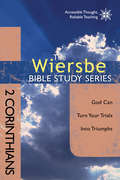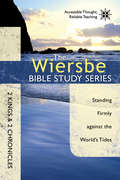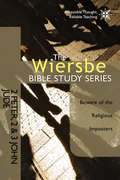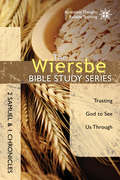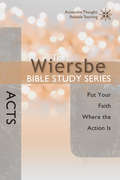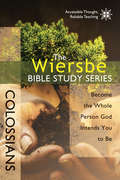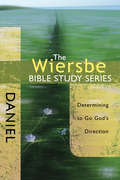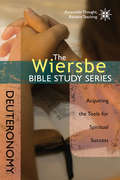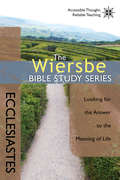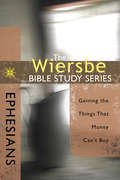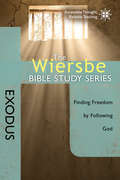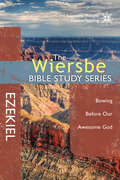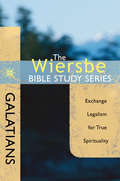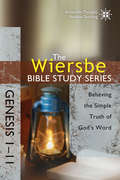- Table View
- List View
The Whole-Brain Child: 12 Proven Strategies to Nurture Your Child's Developing Mind
by Dr. Tina Payne Bryson Dr. Daniel SiegelIn this pioneering, practical book for parents, neuroscientist Daniel J. Siegel and parenting expert Tina Payne Bryson explain the new science of how a child's brain is wired and how it matures. Different parts of a child's brain develop at different speeds and understanding these differences can help you turn any outburst, argument, or fear into a chance to integrate your child's brain and raise calmer, happier children. Featuring clear explanations, age-appropriate strategies and illustrations that will help you explain these concepts to your child, The Whole-Brain Child will help your children to lead balanced, meaningful, and connected lives using twelve key strategies, including:Name It to Tame It: Corral raging right-brain behavior through left-brain storytelling, appealing to the left brain's affinity for words and reasoning to calm emotional storms and bodily tension.Engage, Don't Enrage: Keep your child thinking and listening, instead of purely reacting.Move It or Lose It: Use physical activities to shift your child's emotional state.Let the Clouds of Emotion Roll By: Guide your children when they are stuck on a negative emotion, and help them understand that feelings come and go.SIFT: Help children pay attention to the Sensations, Images, Feelings, and Thoughts within them so that they can make better decisions and be more flexible.Connect Through Conflict: Use discord to encourage empathy and greater social success.
The Whole-Faculty Study Groups Fieldbook: Lessons Learned and Best Practices From Classrooms, Districts, and Schools
by Dale W. Lick Carlene U. MurphyIn this practical guide, an experienced group of contributors provide concrete strategies and real-world examples for implementing this highly successful design for professional learning communities.
The Whole-Faculty Study Groups Fieldbook: Lessons Learned and Best Practices From Classrooms, Districts, and Schools
by Dale W. Lick Carlene U. MurphyIn this practical guide, an experienced group of contributors provide concrete strategies and real-world examples for implementing this highly successful design for professional learning communities.
The Whole-School Audit: Development Planning for Primary and Special Schools
by Brian DrakefordFirst Published in 1997. Routledge is an imprint of Taylor & Francis, an informa company.
The Widening of God's Mercy: Sexuality Within the Biblical Story
by Christopher B Hays Richard B HaysA fresh, deeply biblical account of God&’s expanding grace and mercy, tracing how the Bible&’s narrative points to the full inclusion of LGBTQ people in Christian communities Discussions of the Bible and human sexuality often focus on a scattered handful of specific passages. But arguments about this same set of verses have reached an impasse, two leading biblical scholars believe; these debates are missing the forest for the trees. In this learned and beautifully written book, Richard and Christopher Hays explore a more expansive way of listening to the overarching story that scripture tells. They remind us of a dynamic and gracious God who is willing to change his mind, consistently broadening his grace to include more and more people. Those who were once outsiders find themselves surprisingly embraced within the people of God, while those who sought to enforce exclusive boundaries are challenged to rethink their understanding of God&’s ways. The authors—a father and son—point out ongoing conversations within the Bible in which traditional rules, customs, and theologies are rethought. They argue that God has already gone on ahead of our debates and expanded his grace to people of different sexualities. If the Bible shows us a God who changes his mind, they say, perhaps today&’s Christians should do the same. The book begins with the authors&’ personal experiences of controversies over sexuality and closes with Richard Hays&’s epilogue reflecting on his own change of heart and mind.
The Wiersbe Bible Study Series: 1 & 2 Thessalonians
by Warren W. WiersbeEncourage Each Other and Be Ready The Thessalonian church was struggling with an unbalanced approach to the Second Coming. While they eagerly awaited Christ's return, many believers were placing more value on their future hope than on peoples' current needs. Paul addressed this concern with a message that still resonates today. This study examines Paul's second letter to the Thessalonians and shares the need for a church that is focused on both heaven and earth. The Wiersbe Bible Study Series delivers practical, in-depth guides to selected books of the Bible. Featuring insights from Dr. Warren W. Wiersbe's Be Ready commentary, this eight-week study includes engaging questions and practical applications that will help you connect God's Word with your life.
The Wiersbe Bible Study Series: 1 & 2 Timothy, Titus, Philemon
by Warren W. WiersbeThe Christian life is not easy. Whether we're walking out our faith, sharing the gospel, or helping in ministry, we can become discouraged as we strive to live for Christ. The apostle Paul understood that believers would always face challenges, obstacles, and setbacks. The books of 1 & 2 Timothy, Titus, and Philemon offer a wealth of encouragement for every Christian, and share an underlying, powerful theme: Never give up!The Wiersbe Bible Study Series explores timeless wisdom found in God's Word. Based on Dr. Warren W. Wiersbe's popular "BE" series, each study provides topical, relevant insights from selected books of the Bible. Designed for small groups, this eight-week study features excerpts from Be Faithful, engaging questions, and practical applications, all designed to help you connect God's Word with your life.
The Wiersbe Bible Study Series: 1 Corinthians
by Warren W. WiersbeIn first-century Greece, a fledgling church was struggling to live out their new faith in a corrupt culture. The congregation at Corinth was mired in contradiction, heralding the power of spiritual gifts and knowledge, yet foolishly engaging in sinful behavior. This troubled church inspired the apostle Paul to write one of his most extraordinary letters.The Wiersbe Bible Study Series explores timeless wisdom found in God's Word. Based on Dr. Warren W. Wiersbe's popular "BE" series of commentaries, each study provides topical, relevant insights from selected books of the Bible. Designed for small groups or individuals, this eight-week study explores Paul's call for wisdom in the life of the believer, a truth that remains as relevant as ever.
The Wiersbe Bible Study Series: 1 Kings
by Warren W. WiersbeWhen King David died, he left behind a peaceful kingdom that was following God. Most of the subsequent kings and prophets, however, failed to obey God, and so the nation suffered under exile and oppression.This book of 1 Kings reminds us that moral responsibility in leadership is needed today as much as it was needed in the age of Israel's kings. This study will challenge you to take ownership of your habits and choices, with eternity in mind. The Wiersbe Bible Study Series delivers practical, in-depth guides to selected books of the Bible. Featuring insights from Dr. Warren W. Wiersbe's Be Responsible commentary, this eight-week study includes engaging questions and practical applications that will help you connect God's Word with your life.
The Wiersbe Bible Study Series: 1 Peter
by Warren W. Wiersbe?Often those with the deepest hurt appreciate grace most. Which may explain why Peter, the apostle who once denied his Savior, wrote a remarkable letter that celebrated the hope and grace found in Christ. Based on Warren Wiersbe's Be Hopeful, this eight-week of study of 1 Peter contains fresh insights that help connect God's truth with everyday life.
The Wiersbe Bible Study Series: 1 Samuel
by Warren W. WiersbeBased on 1 Samuel, this Wiersbe Bible Study examines Israel's shift from the leadership of judges to kings, and contrasts the rebellion and genuine success of their first two kings.
The Wiersbe Bible Study Series: 2 Corinthians
by Warren W. WiersbeThe young church in Corinth was making a disheartening discovery: Believers are not immune from trials and pain. Drawing from his own personal struggles, the apostle Paul sent the congregation a remarkable message of encouragement and comfort. Based on his second letter to the Corinthians, this study explores the reality of suffering, the promise of the new covenant, and the hope available to every believer. The Wiersbe Bible Studies Series explores timeless wisdom found in God's word. Based on Dr. Warren W. Wiersbe's popular "BE" series, each study provides topical, relevant insights from selected books of the Bible. Designed for small groups, this eight-week study features selected commentaries from BE Encouraged, engaging questions, and practical applications, all designed to help you connect God's word with your life.
The Wiersbe Bible Study Series: 2 Kings & 2 Chronicles
by Warren W. WiersbeJust as God's people did during the time of 2 Kings and 2 Chronicles, we face pressure today to conform to our culture. But just as the Israelites discovered thousands of years ago, conformity comes at a high price. This in-depth study of two kingdoms calls you to stand out from the crowd in work, relationships, and faith. When you choose to be distinct, you can offer hope and light to a needy world. The Wiersbe Bible Study Series delivers practical, in-depth guides to selected books of the Bible. Featuring insights from Dr. Warren W. Wiersbe's Be Distinct commentary, this eight-week study includes engaging questions and practical applications that will help you connect God's Word with your life.
The Wiersbe Bible Study Series: 2 Peter, 2&3 John, Jude
by Warren W. WiersbeThe early church was facing a growing problem: Spiritual counterfeits. From false doctrine to mixed messages, Christians were struggling to separate fact from fiction. Sensing this threat to their young churches the apostles rallied to defend the Gospel in an extraordinary series of letters. This study of 2 Peter, 2 & 3 John, and Jude explores how we can discern truth and stand firm on God's word. The Wiersbe Bible Study Series explores timeless wisdom found in God's word. Based on Dr. Warren W. Wiersbe's popular "BE" series, each study provides topical, relevant insights from selected books of the Bible. Designed for small groups, this eight-week study features selected commentaries from Be Delivered, engaging questions, and practical applications, all designed to help you connect God's word with your life.
The Wiersbe Bible Study Series: 2 Samuel and 1 Chronicles
by Warren W. WiersbeGod longs to restore fractured relationships, broken souls, and divided churches--and He wants to use imperfect people to do it. In 2 Samuel and 1 Chronicles, we see David facing a divided nation and his own sin. Yet God used David to restore the country, the throne, and his heart, showing that no personal or national situation is beyond God's ability to bring wholeness. The Wiersbe Bible Study Series delivers practical, in-depth guides to selected books of the Bible. Featuring insights from Dr. Warren W. Wiersbe's Be Restored commentary, this eight-week study includes engaging questions and practical applications that will help you connect God's Word with your life.
The Wiersbe Bible Study Series: Acts
by Warren W. WiersbeThe book of Acts chronicles the birth and growth of the early church. It tells the story of ordinary people who were pioneers for Christ, as they experienced His transforming power in their lives and communities. And while some miracles are unique to the early church, God's power is still available to His people today; a truth that can inspire us to boldly pursue His plans and purposes. The study explores the power of God's Spirit, and how that power can impact our lives today.The Wiersbe Bible Studies Series explores timeless wisdom found in God's word. Based on Dr. Warren W. Wiersbe's popular "BE" series, each study provides topical, relevant insights from selected books of the Bible. Designed for small groups, this eight-week study features selected commentaries from BE Dynamic, engaging questions, and practical applications, all designed to help you connect God's word with your life.
The Wiersbe Bible Study Series: Colossians
by Warren W. WiersbeIn a world with a religion to meet every diverse mood, today's Christians are no different from those of ancient Colossae. Fighting Jewish legalism mixed with Eastern philosophies and Gnosticism, Paul called on the Colossian church to stop partaking in the misguided religious practices of their day and to find the one true faith. In his profound, scholarly letter, Paul warned the people of their heretical practices. His prevailing theme is the preeminence of Christ. Paul knew that if the Colossians grasped even a glimpse of the fullness of God, they would seize hold of their true identity and stop looking elsewhere for spiritual fulfillment. In this Bible study based on his original commentary on Colossians, seasoned pastor Dr. Warren W. Wiersbe challenges twenty-first-century believers in another age of "religious tolerance." Using Paul's response to heresy as one example, you will learn how to respond diplomatically yet boldly to the falsehood that aims to corrupt our faith today.
The Wiersbe Bible Study Series: Daniel
by Warren W. WiersbeHis name meant "God is my judge," and his life bore witness to that fact. Daniel was a man who knew the Most High. An intimate friend of God, he realized simultaneously that friendship cost time kneeling in humility. He understood God's sovereignty, even in pagan Babylon where the Jews were exiled, and he refused to compromise his faith. Daniel's resolution meant sacrifice. It meant discipline in prayer, diplomacy with government leaders, and dedication to living "set apart." It meant depending on an unchanging God to give him an unwavering vision. Amid a pagan nation, an arrogant king, ravenous lions, and a blazing furnace, Daniel and his friends sought God and found Him in a way that will inspire and strengthen your journey. The same God who shut the lions' mouths and rescued His men unscathed from the flames will consecrate you to dream His dreams and do His work if only you allow Him. Do you have what it takes?
The Wiersbe Bible Study Series: Deuteronomy
by Warren W. WiersbeDeuteronomy brings us to the feet of one of history's greatest teachers. The Israelites were about to enter an unknown land that had a culture radically different from their own. Moses equipped them with God's truth so they could move forward without fear. Today we can also find courage and direction in Moses's words as we learn how to use the lessons of the past, why God's law is the best foundation, and what it means to share in God's covenant. The Wiersbe Bible Study Series delivers practical, in-depth guides to selected books of the Bible. Featuring insights from Dr. Warren W. Wiersbe's Be Equipped commentary, this eight-week study includes engaging questions and practical applications that will help you connect God's Word with your life.
The Wiersbe Bible Study Series: Ecclesiastes
by Warren W. WiersbeThe book of Ecclesiastes tackles one of our biggest questions: What is the meaning of life? Commonly considered the work of King Solomon, Ecclesiastes is a rich collection of profound insights that are at once poetic, philosophical, and practical. This Bible study examines the big ideas in Ecclesiastes, explains challenging concepts, and shares how we can be truly satisfied. The Wiersbe Bible Studies Series explores timeless wisdom found in God's word. Based on Dr. Warren W. Wiersbe's popular "BE" series, each study provides topical, relevant insights from selected books of the Bible. Designed for small groups, this eight-week study features selected commentaries from BE Satisfied, engaging questions, and practical applications, all designed to help you connect God's word with your life.
The Wiersbe Bible Study Series: Ephesians
by Warren W. WiersbeAmid a society where wealth is often the measurement of success, popular author Warren Wiersbe unpacks the book of Ephesians to prove the countercultural nature of the Gospel. Through helpful illustrations and analysis, he opens your eyes to the riches that believers already have, frequently without knowing or taking advantage of them. Ultimately, believers have salvation, and with this gift comes many other blessings. You have the Holy Spirit empowering you for the work of the Kingdom. You have the necessary spiritual armor fighting off enemy attacks. You have never-fading wealth promising eternity with a perfect God. Not only has God given you the "engagement ring" of His Holy Spirit as a promise for eternal bliss, but you already have the victory that Christ bought on your behalf! Perhaps you don't know how rich you are--yet. You'll soon see that the tangible things of this life can never amass an eternal fortune.
The Wiersbe Bible Study Series: Exodus
by Warren W. WiersbeThe book of Exodus chronicles the Israelites' epic journey from slavery to freedom. Yet it's also a journey plagued by fear, doubt, and distrust in God. Today the story remains the same, as a loving God continues to deliver broken people. This study takes an in-depth look at the Israelites' difficult path to the Promised Land, and reveals the freedom found in trusting a faithful God. The Wiersbe Bible Study Series explores timeless wisdom found in God's word. Based on Dr. Warren W. Wiersbe's popular "BE" series, each study provides topical, relevant insights from selected books of the Bible. Designed for small groups, this eight-week study features selected commentaries from Be Delivered, engaging questions, and practical applications, all designed to help you connect God's word with your life.
The Wiersbe Bible Study Series: Ezekiel
by Warren W. WiersbeWhen the Isrealites lost respect for God's majesty, God called the prophet Ezekiel to remind His people of His holy nature. Ezekiel's message is just as relevant for us today as it was for the Jewish people thousands of years ago. This study of Ezekiel explores what it means to worship God as a holy Lord who is worthy of our reverence.The Wiersbe Bible Study Series delivers practical, in-depth guides to selected books of the Bible. Featuring insights from Dr. Warren W. Wiersbe's Be Reverent commentary, this eight-week study includes engaging questions and practical applications that will help you connect God's Word with your life.
The Wiersbe Bible Study Series: Galatians
by Warren W. WiersbeThe book of Galatians carries a dangerous message. It's propelled by a radical idea that continues to challenge man-made beliefs and principles: The Christian religion is not about religion at all. It's about a relationship restored, and living by love, not legalism. In this study of the book of Galatians, we find Paul's battle cry for the true gospel and encounter the freedom found in placing our faith in Christ alone.The Wiersbe Bible Study Series explores timeless wisdom found in God's Word. Based on Dr. Warren W. Wiersbe's popular "BE" series, each study provides topical, relevant insights from selected books of the Bible. Designed for small groups, this eight-week study features excerpted commentary from Be Free, engaging questions, and practical applications, all designed to help you connect God's Word with your life.
The Wiersbe Bible Study Series: Genesis 1-11
by Warren W. WiersbeIn a cluttered and confusing world, there's value in getting back to basics. The first eleven chapters of Genesis offer foundational truths on faith, sin, and relationships--both with God and others. This study guide provides a panoramic view of the beginning of life, while exploring God's basic values for His people. Wiersbe Bible Studies deliver practical, in-depth guides to selected books of the Bible. Featuring insights from Wiersbe's Be Basic commentary, this eight-week study features engaging questions and practical applications that will help you connect God's word with your life.
